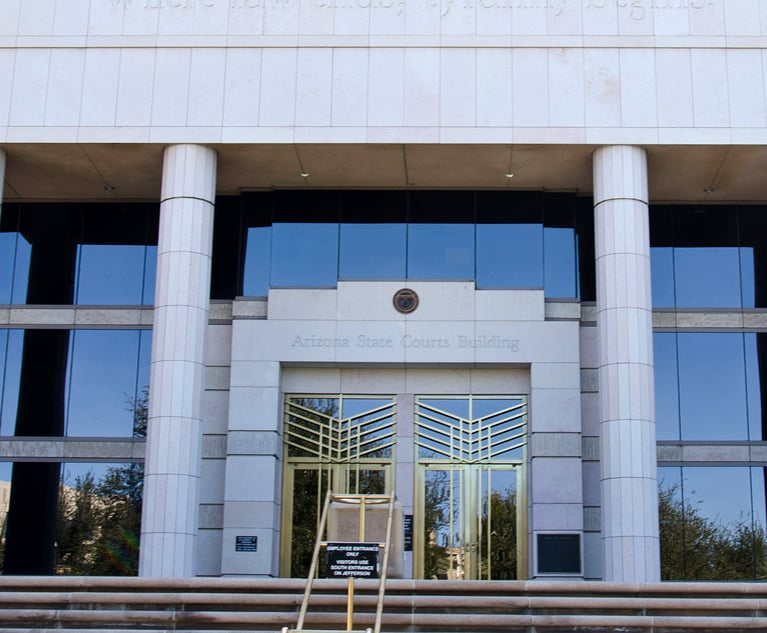Waiting for the tide – will the expected flood of financial crisis negligence claims ever surface?
In the wake of the global credit crisis of 2007 and 2008, there was an expectation among some lawyers that a 'tsunami' of professional negligence work was bound to follow. Their hope was based on the theory that during boom times, companies make more use of professional advice to secure property deals, plan construction projects, and launch mergers and acquisitions, while claims for negligence become far less common. But when the economy flatlines and companies and individuals see the value of portfolios nose dive – thanks to falling or stagnating property prices and market values – they 'reappraise' the quality of that expert advice and seek to claw back their money in the courts.
July 04, 2013 at 07:03 PM
11 minute read
Law firms have staffed up to cope with the expected surge in credit crisis negligence work. But, as Neil Hodge reports, this has proved to be more of a trickle than a flood
In the wake of the global credit crisis of 2007 and 2008, there was an expectation among some lawyers that a 'tsunami' of professional negligence work was bound to follow.
Their hope was based on the theory that during boom times, companies make more use of professional advice to secure property deals, plan construction projects, and launch mergers and acquisitions, while claims for negligence become far less common.
But when the economy flatlines and companies and individuals see the value of portfolios nose dive – thanks to falling or stagnating property prices and market values – they 'reappraise' the quality of that expert advice and seek to claw back their money in the courts.
So after the financial crisis, conditions seemed ideal for a flood of professional indemnity (PI) claims, with many law firms taking on more staff to cope with a surge in demand. Eversheds and TLT have, for example, hired dedicated professional negligence lawyers to help with the workload, while Berwin Leighton Paisner (BLP) has taken on paralegals to work on document reviews. RPC is seeking a couple of new hires, while firms such as Kennedys and Clyde & Co have expanded or set up dedicated regional offices to deal with professional indemnity work.
Yet sector specialists agree that while there may have been an increase in work, it has certainly not reached the heights some had anticipated.
A steady stream
"A few years ago, there was talk of a 'tsunami' of negligence claims heading our way," says James Miller, head of insurance at RPC. "In reality, it has been more like a few extra inches at high tide. PI work has picked up across the market and firms have taken on extra staff to deal with it, but it has certainly not been anything like the surge that some expected."
Most law firms have a similarly sober view of the market since the financial crisis began to take its toll, acknowledging that there has been a rise – but not necessarily a dramatic one. Sarah Clover, Clyde & Co's head of professional liability (pictured, below), says: "We continue to see a steady stream of claims against firms, as well as an increase in the severity of claims against law firms. We have also seen a rise in the number of speculative large claims against firms."
Yet some still hold to the possibility – or hope – of a last-minute rush of companies pursuing negligence claims.
Alex Jakubowski, a partner in the dispute resolution team at Clarke Willmott, says: "Law firms are probably at the tail-end of the claims arising from the financial crisis. The six-year limit period for litigants to make a claim [following the onset of the financial crisis] is almost up, so we may see a final spurt of people making negligence claims in the next few months."
The Jackson barrier
There may be, however, a significant barrier to this happening. The Jackson reforms, designed to make legal costs 'appropriate', came into effect recently.
From April, parties that previously funded litigation via conditional fee agreements (CFAs) and/or after-the-event (ATE) insurance will now find that the CFA success fee and ATE premium are no longer recoverable from the losing opponent if the case is successful. Parties can still enter into CFAs and take out ATE insurance to fund litigation, but have to bear the extra costs themselves.
In Lord Justice Jackson's view, the effect of the previous arrangements was that claimants could litigate "risk free" at huge cost to losing defendants. Unsurprisingly, the changes are not popular with claimant lawyers, who say the reforms will restrict access to justice and reduce damages to seriously injured clients.
Andrew Myers, litigation partner at Stephenson Harwood, is "concerned that the Government has denied access to justice to smaller companies and individuals who have been poorly served by professionals and who are – as a result of the reforms – unable to afford adequate redress".
He adds: "It means that professional firms can fail their clients and get away with it."
Prime targets
Lawyers agree that their own profession is one of the prime targets for negligence claims, particularly in relation to conveyancing, wills and probate.
Others advising the construction industry – such as architects and surveyors – are also regular targets, while accountants, tax specialists and financial advisers are under increasing fire, particularly for mis-selling.
Richard Palmer, head of Watson Burton's professions and insurance group, says the volume of PI work has picked up over the past few years largely because of "over-optimistic property valuations by valuers and a failure by solicitors to adequately check the details for their clients, particularly in construction-related deals".
Carol Davies, a barrister at Southampton's College Chambers, believes claim numbers will continue to rise. "There is an element of society that is generally more willing to complain and to seek legal assistance as to potentially wrong advice or services," she says, adding that "years of economic decline and austerity may also make clients more intent in seeking recompense".
Although lawyers are confident that the PI and negligence market will stay strong, many predict a reduction in the number of law firms doing the work. Their chief reason is that the work is becoming increasingly complex, while insurers will probably reshape the market through their choice of legal provider and types of fee structure. Davies believes: "It is likely that the larger firms specialising in professional indemnity claims will retain and handle the majority of cases. This is particularly so since the insurers for the professionals use larger law firms."
Some also think the PI market is increasingly niche. Kennedys partner Matt Andrews says: "We have seen a consolidation of insurance practices over the past few years and the expectation is that this has not yet run its course. There are now fewer law firms offering specialism in the handling of PI matters and those that do it well have increased their expertise and depth in this field.
"For example, we have continued to grow, recruiting PI specialists at all of our UK offices that deal with PI, namely in London, Manchester, Birmingham, Belfast and Taunton."
Andrews also believes PI is not attractive to new market entrants: "It is not a boom area where law firms can 'dabble'. It is a competitive market with clients who demand good service at competitive rates. If you want to survive or thrive, there is no substitute for a solid, well-proportioned and geographically diverse PI practice."
However, Richard Power, a partner in BLP's litigation and dispute resolution department, says he thinks there is still a place for smaller firms, which can do the more straightforward work while larger rivals become more niche and specialised.
"There is going to be more pressure on fees and insurers and claimants are going to want more certainty over costs," he says. "Large firms are still billing using the hourly rate and that pricing model is just not competitive enough for the long term."
Expert advice
Some law firms think an important selling point in future will be whether they employ industry experts, including lawyers with industry-accredited qualifications in areas such as financial services and construction.
Jakubowski says: "Law firms are going to have to improve their skills and knowledge of the particular industry sectors that they are going to represent. For example, law firms representing construction firms are going to need lawyers in their teams who have deep knowledge of construction issues – how they operate, the risks they face, how they are managed, and so on. It will no longer be enough to just be an expert in handling negligence claims."
Some say the PI market for lawyers is already changing, with the template being set by the insurance industry. Palmer says insurers are putting more pressure on law firms over fees to help settle claims, which is forcing the legal sector to become more efficient and innovative on pricing.
"Since the 'no win, no fee' regime has changed, insurers are putting more pressure on law firms because they are not going to tolerate paying the hourly rate, so they are pushing for fixed or capped fees.
"Insurers are certainly driving the market, and this may be opening up more opportunities for regional firms to take on PI work because they can provide the service more cheaply than London-based firms."
Clover agrees that insurers require much of the defence work to be carried out in the regions to keep down costs. Clyde & Co set up a dedicated professional liability centre in Oxford in 2008 and another in Manchester in 2010.
"It was our response to the way the market was moving," she says. "We wanted to say to insurers that we are capable of providing high-level work to firms of all sizes as cost effectively as possible."
Meanwhile, better risk management by the professions appears to be capping the number of claims pursued by insurers. Andrews says: "While we have seen an increase in the number of PI claims with which we are dealing, we are not seeing a trend showing a major increase in the number of claims being sent out to panel law firms as a whole by PI insurers.
"If anything, it appears the number of claims that some players in the PI market are sending out to panel is reducing. My perception is that it is due to a combination of factors, including increased appreciation of risk management by professionals; the economic climate dissuading some potential claimants; and more effective claims handling by insurers."
Other lawyers agree that improved risk management and corporate governance is limiting the number of PI claims and their severity. Simon Konsta, global board member at Clyde & Co and partner responsible for the insurance practice, says: "Over the past few years, professional services firms – solicitors, financial services firms, valuers and so on – have improved their risk management and embedded better internal controls and procedures."
Miller agrees: "More effective regulation, better standards of practice, better corporate governance and risk management have all helped keep the number of negligence claims steady."
The short-term prognosis for the law firm PI market – namely the next two to three years – remains promising, lawyers say. But they warn that its potential has limits.
Andrews says solicitors will always see a steady flow of PI claims and that this will probably not change in a big way. However, he believes there will be "tweaks".
"An increased number of solicitors' practices are ceasing to trade or have needed an intervention, including some that have struggled with effective risk management. That might mean those who are left have better risk management processes and fewer claims. We are also seeing a downturn in the numbers of claims by lenders – although there is still some distance for that to run."
Fee deterrent
Ross Risby, a partner in the professional and financial lines group at DAC Beachcroft, believes insurer fee pressure will either force some existing participants to exit the market or deter others from entering.
"Pressure on rates means an ever-increasing drive towards intelligent and flexible solutions for handling all claims – from the under-settlement of a minor personal injury claim to the failure of multimillion-pound tax avoidance schemes.
"Any new entrants will need to convince the insurers that they have a genuinely novel approach to dealing with claims that not only leads to lower legal costs, but also minimises claims payments. Insurers recognise there is little point in reducing their legal spend if that is more than made up by increased claims payments."
There is no doubt the PI market is changing and firms expect conditions to toughen. But they are still upbeat about immediate prospects despite the absence of that anticipated tidal wave of claims.
As Power concludes: "Whenever there is a downturn, there is always an increase in negligence claims. That has been true for the past few years, and is likely to be true for the next few."
This content has been archived. It is available through our partners, LexisNexis® and Bloomberg Law.
To view this content, please continue to their sites.
Not a Lexis Subscriber?
Subscribe Now
Not a Bloomberg Law Subscriber?
Subscribe Now
NOT FOR REPRINT
© 2025 ALM Global, LLC, All Rights Reserved. Request academic re-use from www.copyright.com. All other uses, submit a request to [email protected]. For more information visit Asset & Logo Licensing.
You Might Like
View All
KPMG's Bid To Practice Law in US On Hold As Arizona Court Exercises Caution

Combative Arguments at EU's Highest Court Over Google's €4.13B Antitrust Fine Emphasize High Stakes and Invoke Trump
4 minute read
Law Firms 'Struggling' With Partner Pay Segmentation, as Top Rainmakers Bring In More Revenue
5 minute readTrending Stories
Who Got The Work
J. Brugh Lower of Gibbons has entered an appearance for industrial equipment supplier Devco Corporation in a pending trademark infringement lawsuit. The suit, accusing the defendant of selling knock-off Graco products, was filed Dec. 18 in New Jersey District Court by Rivkin Radler on behalf of Graco Inc. and Graco Minnesota. The case, assigned to U.S. District Judge Zahid N. Quraishi, is 3:24-cv-11294, Graco Inc. et al v. Devco Corporation.
Who Got The Work
Rebecca Maller-Stein and Kent A. Yalowitz of Arnold & Porter Kaye Scholer have entered their appearances for Hanaco Venture Capital and its executives, Lior Prosor and David Frankel, in a pending securities lawsuit. The action, filed on Dec. 24 in New York Southern District Court by Zell, Aron & Co. on behalf of Goldeneye Advisors, accuses the defendants of negligently and fraudulently managing the plaintiff's $1 million investment. The case, assigned to U.S. District Judge Vernon S. Broderick, is 1:24-cv-09918, Goldeneye Advisors, LLC v. Hanaco Venture Capital, Ltd. et al.
Who Got The Work
Attorneys from A&O Shearman has stepped in as defense counsel for Toronto-Dominion Bank and other defendants in a pending securities class action. The suit, filed Dec. 11 in New York Southern District Court by Bleichmar Fonti & Auld, accuses the defendants of concealing the bank's 'pervasive' deficiencies in regards to its compliance with the Bank Secrecy Act and the quality of its anti-money laundering controls. The case, assigned to U.S. District Judge Arun Subramanian, is 1:24-cv-09445, Gonzalez v. The Toronto-Dominion Bank et al.
Who Got The Work
Crown Castle International, a Pennsylvania company providing shared communications infrastructure, has turned to Luke D. Wolf of Gordon Rees Scully Mansukhani to fend off a pending breach-of-contract lawsuit. The court action, filed Nov. 25 in Michigan Eastern District Court by Hooper Hathaway PC on behalf of The Town Residences LLC, accuses Crown Castle of failing to transfer approximately $30,000 in utility payments from T-Mobile in breach of a roof-top lease and assignment agreement. The case, assigned to U.S. District Judge Susan K. Declercq, is 2:24-cv-13131, The Town Residences LLC v. T-Mobile US, Inc. et al.
Who Got The Work
Wilfred P. Coronato and Daniel M. Schwartz of McCarter & English have stepped in as defense counsel to Electrolux Home Products Inc. in a pending product liability lawsuit. The court action, filed Nov. 26 in New York Eastern District Court by Poulos Lopiccolo PC and Nagel Rice LLP on behalf of David Stern, alleges that the defendant's refrigerators’ drawers and shelving repeatedly break and fall apart within months after purchase. The case, assigned to U.S. District Judge Joan M. Azrack, is 2:24-cv-08204, Stern v. Electrolux Home Products, Inc.
Featured Firms
Law Offices of Gary Martin Hays & Associates, P.C.
(470) 294-1674
Law Offices of Mark E. Salomone
(857) 444-6468
Smith & Hassler
(713) 739-1250









